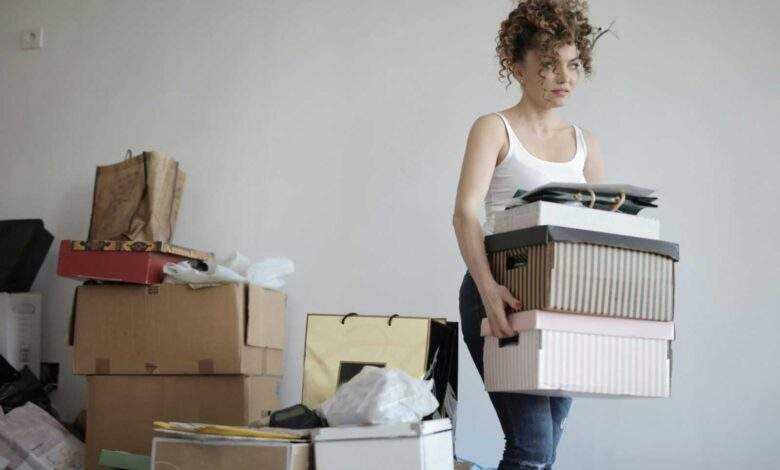Declutter and Donate: Give Your Belongings a Second Life

Table of Contents
Declutter and Donate can be a transformative process, offering not only a cleaner living space but also a sense of mental clarity. To begin, it’s essential to categorize your items. Start by sorting them into specific groups: keep, sell, donate, and discard. This methodical approach helps in evaluating each item’s value and utility. When deciding what to keep, consider whether the item serves a functional purpose or holds meaningful sentimental value. If an item doesn’t fit these criteria, it might be time to let it go.
Setting realistic goals is another crucial step. Break down your decluttering project into manageable tasks, such as focusing on one room or even one closet at a time. This helps to prevent feeling overwhelmed and keeps you motivated as you see progress. A declutter challenge, like tackling a specific area each day for a week, can also add a structured approach to your efforts.
For items that you decide to part with, responsible donation is key. Researching where to donate clothes near you ensures that your contributions reach those in need and are used effectively. Many organizations accept a wide range of items, from clothing and books to furniture and electronics. By choosing reputable charities, you can be confident that your donations make a positive impact. Additionally, some decluttering apps can assist you in finding local donation centers and scheduling pickups, simplifying the process.
Understanding what to do with old stuff is equally important. While some items can be sold online or at a garage sale, others may be best donated. For larger items, such as furniture, seek out organizations that offer pickup services. This not only makes it easier for you but also ensures that the items are reused in a beneficial way.
Implementing these decluttering tips can significantly enhance your living environment. Embracing minimalist living tips can also aid in maintaining a clutter-free home moving forward. By regularly assessing your belongings and donating responsibly, you contribute to a more organized and purposeful lifestyle, while also supporting those in need.
Declutter Your Home with Kids
Decluttering your home, especially with kids, can be both a challenging and rewarding experience. Engaging children in the process not only helps to declutter your home but also instills valuable life skills. Here are some effective tips and techniques to make the decluttering process fun and educational for your kids.
Start by establishing age-appropriate responsibilities. Younger children can begin with simple tasks like sorting toys into bins or deciding which clothes they no longer wear. Older kids can take on more complex responsibilities, such as organizing their own rooms or helping to donate clothes and toys. This not only eases the decluttering process but also teaches them to take ownership of their space.
Make decluttering a game to keep them engaged. Create a declutter challenge by setting a timer and seeing who can fill a donation box the fastest. Use rewards like extra playtime or a special treat to motivate them. Gamifying the process makes it enjoyable and encourages them to participate willingly. Additionally, involve them in the decision-making process about what to keep and what to let go of. This helps them develop critical thinking skills and understand the value of their possessions.
Teaching children about donation and charity is another essential aspect. Explain the importance of donating their old stuff to those in need. Take them to local donation centers to show where their items go, enhancing their understanding of responsible donating. Discuss the impact of their contributions and how they are helping others, fostering a sense of empathy and community responsibility.
Fostering a minimalist mindset from a young age can have long-term benefits. Encourage your children to appreciate quality over quantity. Explain the benefits of minimalist living and how having fewer possessions can lead to a more organized and stress-free environment. Utilize decluttering apps to make the process more interactive and to track progress. These tools can help children visualize their efforts and the positive changes in their living space.
By incorporating these decluttering tips, you can turn the process into a meaningful family activity. It not only helps to declutter your home but also teaches your children valuable lessons about organization, responsibility, and charity.
Most Ethical Clothing Donation Centers
When deciding to declutter your home, particularly your wardrobe, it’s important to consider not just where to donate clothes near you, but also the ethical impact of your donation. Ethical clothing donation centers are those that prioritize transparency, positively impact local communities, and uphold principles of environmental sustainability.
Transparency is a crucial factor in evaluating donation centers. Reputable organizations openly disclose how donated items are used, ensuring that a significant portion directly benefits those in need. For example, Goodwill Industries provides detailed reports on the allocation of donated items, which are often sold in their thrift stores to fund job training and employment placement services for disadvantaged populations.
Another key criterion is the impact on local communities. Ethical donation centers work closely with community organizations to address specific needs. The Salvation Army, for instance, channels proceeds from their thrift stores into a variety of social services, including emergency shelter, food pantries, and rehabilitation programs. Their localized approach ensures that donations have a tangible, positive effect on the community.
Environmental sustainability is also a significant consideration. Many ethical donation centers have adopted green initiatives to minimize waste and reduce their carbon footprint. For example, Planet Aid collects used clothing and shoes, which are then recycled or repurposed, reducing landfill waste. Their mission includes environmental education and sustainable development projects in impoverished areas, making them a leader in eco-friendly donation practices.
To make informed choices, look for organizations with clear missions and a track record of ethical practices. Researching online reviews and visiting the centers can provide additional insights. By choosing ethical donation centers, you not only declutter your home but also contribute to meaningful, responsible change. Whether you decide to donate clothes, furniture, or other items, ensuring that your contributions are ethically managed can make a significant difference.
How to Prepare Furniture for Declutter and Donate
Properly preparing your furniture for donation is crucial to ensure it can be reused and appreciated by others. The initial step in this process is thorough cleaning. Begin by dusting and wiping down the surfaces with appropriate cleaning agents, ensuring all grime and stains are removed. For upholstered items, consider steam cleaning or using fabric-safe cleaners to eliminate any lingering odors or marks. Clean furniture not only looks more appealing but also adheres to most donation centers’ standards.
Next, address any minor damages. Inspect the furniture for loose screws, wobbly legs, or small tears in the fabric. Simple repairs can significantly enhance the usability and longevity of the items. Tighten any screws or bolts, apply wood glue to secure joints, and patch up minor fabric damages if possible. While you may not be able to fix everything, making these small adjustments ensures the furniture is in the best possible condition for its next owner.
It’s important to ensure that the furniture meets the donation center’s requirements. Different centers have varying criteria for acceptable donations. Some may not accept items with significant damage, while others might have restrictions on size or material. Contact the donation center beforehand or check their website to understand their specific guidelines. This step helps you avoid the disappointment of having your donation rejected and ensures the furniture will indeed find a new home.
Finally, consider the logistics of transporting the furniture to the donation site. If you have a large vehicle, carefully load the furniture, ensuring it is securely fastened to prevent any damage during transit. For those without access to suitable transport, many donation centers offer pick-up services. Schedule a pick-up and ensure the furniture is easily accessible for the collection team. Proper preparation and responsible donating can help others benefit from your pre-loved items, contributing to a more sustainable and minimalist living environment.
Decluttering for Mental Health
Decluttering your home can have a profound impact on your mental health, offering a range of psychological benefits including reduced stress, improved focus, and enhanced overall well-being. The process of getting rid of stuff goes beyond just physical space; it can significantly contribute to mental clarity and emotional stability.
Several studies have indicated that a cluttered environment can lead to increased levels of anxiety and stress. When your surroundings are chaotic, it often mirrors a chaotic mind. By decluttering and organizing your space, you create a sense of order that can translate into mental calmness. Minimalist living tips often emphasize the mental relief that comes from a clean, organized space.
Personal stories often highlight the profound impact of decluttering on mental health. For instance, Jane, a busy mother of two, found that taking on a declutter challenge not only made her home more livable but also significantly reduced her stress levels. She started with small steps, using decluttering apps to manage the process and gradually moved on to larger tasks like deciding what to do with old stuff. The act of decluttering her room provided her with a renewed sense of control and peace.
Expert insights also back these personal experiences. Psychologists suggest that a decluttered space can lead to improved focus and productivity. When you donate clothes or donate furniture that you no longer need, you’re not just freeing up physical space; you’re also freeing up mental space. Responsible donating can further add a sense of fulfillment and purpose, knowing that your items are given a second life and are helping those in need.
Whether you’re wondering where to donate clothes near me or looking for decluttering tips, the act of decluttering your home can be a transformative experience. It’s not just about the physical act of removing items but also about creating an environment conducive to mental well-being. By taking steps to declutter and organize, you pave the way for improved mental health and overall quality of life.
Best Apps for Decluttering Clothes
In today’s digital age, technology can be an invaluable ally when it comes to decluttering and organizing your home. Several innovative apps offer comprehensive solutions for managing your wardrobe, making it easier to donate clothes, sell items, or simply get rid of stuff you no longer need. Here, we explore some of the best apps available for decluttering clothes, highlighting their features, user-friendliness, and overall effectiveness.
Wardrobe Organization Apps
Wardrobe organization apps like Stylebook and Cladwell are designed to help you catalog your clothing items, create outfits, and track what you wear. Stylebook allows users to upload images of their wardrobe, categorize items, and build a virtual closet. This app also offers features like outfit planning and packing lists, making it easier to identify pieces you no longer wear and should consider donating. Cladwell, on the other hand, focuses on helping users build a minimalist wardrobe by suggesting daily outfits based on the items you already own. Both apps can be instrumental in the decluttering process by giving you a clear visual of your wardrobe, helping you make informed decisions about what to keep and what to let go.
Resale Platforms
If you’re looking to resell some of your clothes, apps like Poshmark, Depop, and ThredUp offer user-friendly platforms for listing and selling items. Poshmark and Depop allow you to create listings with photos and descriptions, while ThredUp offers a more hands-off approach by sending you a clean-out kit to fill and send back for appraisal. These apps not only help you declutter but also provide an opportunity to earn some extra income from items you no longer need.
Donation Tracking Tools
For those who prefer to donate clothes, apps like Goodwill’s Donation Tracker and Charity Miles can be incredibly useful. Goodwill’s Donation Tracker allows users to keep a digital record of their donations, which is helpful for tax purposes. Charity Miles, although primarily a fitness app, partners with various charities and tracks your physical activity, converting it into donations. These tools ensure that your decluttering efforts contribute positively to your community.
By leveraging these apps, you can streamline the process of decluttering your home, ensuring that your unwanted clothes find a new purpose. Whether you aim to donate, resell, or simply organize, there’s an app tailored to meet your needs, helping you achieve a clutter-free and organized living space.
Minimalist Living on a Budget
Embracing a minimalist lifestyle does not necessarily require a significant financial outlay. Instead, it focuses on prioritizing needs over wants, which can be both cost-effective and liberating. The first step to declutter your home is to assess what you truly need versus what you merely desire. This mindful approach helps in reducing unnecessary purchases, thereby saving money.
When it comes to furnishing your minimalist space, look for affordable minimalist furniture and decor. Thrift stores, online marketplaces, and garage sales are excellent places to find budget-friendly options. You can also explore DIY projects for creating simple yet functional furniture. Repurposing existing items is another fantastic way to minimize expenses. For example, an old wooden pallet can be transformed into a stylish coffee table with a little creativity and minimal investment.
Another essential aspect of minimalist living is learning how to declutter and organize effectively. Utilize decluttering tips such as the “one in, one out” rule, where you only introduce a new item if you get rid of an old one. This practice helps maintain a balance and prevents accumulation of unnecessary stuff. Decluttering apps can also assist in managing your belongings and keeping track of what you have.
Budget-friendly minimalist living also involves responsible donating. When you decide to donate clothes or donate furniture, research where to donate clothes near you, ensuring your items find a new home with someone who needs them. Engaging in a declutter challenge can motivate you to consistently evaluate and streamline your possessions.
Minimalist living is not just about reducing physical items but also about adopting a mindset that values simplicity and intentionality. These minimalist living tips emphasize that you don’t need to spend a lot to achieve a clutter-free, organized, and serene living space. By making thoughtful choices and leveraging available resources, minimalist living on a budget becomes both attainable and sustainable.
Declutter Challenge for Beginners
Embarking on a declutter journey can feel overwhelming, especially for beginners. However, a structured declutter challenge can simplify the process and make it more manageable. This step-by-step challenge is designed to guide you through decluttering your home, one task at a time, ensuring a smooth transition to a clutter-free life.
The challenge spans four weeks, with daily tasks that gradually build upon each other. Each week focuses on different areas of your home, allowing you to systematically declutter and organize. Here’s a breakdown of the weekly tasks:
Week 1: Personal Spaces
Start with areas you use most often, such as your bedroom and bathroom. On Day 1, focus on your closet. Remove all items, evaluate what you wear regularly, and donate clothes you no longer need. By the end of the week, you should have a streamlined wardrobe and organized personal items.
Week 2: Living Areas
Shift your attention to communal spaces like the living room and dining area. Day 8 could be dedicated to decluttering your bookshelves, while Day 9 might involve organizing your entertainment center. Donate furniture or decor items that no longer serve a purpose.
Week 3: Kitchen and Pantry
The kitchen can be a hotspot for clutter. Day 15’s task could involve sorting through your pantry, discarding expired items, and donating non-perishables you won’t use. By the end of Week 3, aim to have a clean, functional kitchen space.
Week 4: Storage Areas
Finally, tackle storage spaces like the garage, attic, or basement. Day 22 might involve organizing holiday decorations, while Day 23 could focus on old tools or sports equipment. Identify what to do with old stuff, be it recycling, donating, or responsibly disposing of it.
Throughout the challenge, keep yourself motivated by tracking your progress. Use decluttering apps or a simple journal to document your achievements. Reading success stories from others who have successfully decluttered can also provide inspiration. Remember, the goal isn’t just to get rid of stuff, but to create a more organized, minimalist living environment. By the end of the four weeks, you should feel a sense of accomplishment and enjoy a clutter-free home.
Where to Donate Used Books
Books hold a special place in many people’s hearts, and donating them can give these cherished items a new lease on life. If you’re looking to declutter your home and donate books responsibly, there are several local options to consider. Libraries often accept gently used books to expand their collections or sell in fundraising events. Contact your local library to understand their specific donation guidelines and needs.
Schools are another excellent option for book donations. Many schools welcome donations of age-appropriate books to enrich their libraries or classrooms. Reach out to nearby schools to determine if they have a need for the types of books you have. Similarly, community centers frequently run programs or book drives and can benefit greatly from donated books that can be used in educational or recreational activities.
Charitable organizations such as Goodwill, The Salvation Army, and local shelters also accept book donations. These organizations often sell the books to fund their charitable activities or distribute them directly to those in need. Researching “where to donate clothes near me” can also yield results for book donation centers, as these locations often accept a wide range of items.
When preparing to donate books, it’s essential to assess their condition. Ensure that they are free from excessive wear, such as torn pages, water damage, or significant markings. Books should be in a state that you would feel comfortable giving as a gift. Sorting through your collection will help you decide what to do with old stuff, separating those suitable for donation from those that are better recycled.
For those who prefer a more convenient approach, there are decluttering apps available that can help locate nearby donation centers. These apps can offer a declutter challenge, motivating you to clear out your space efficiently. Embracing minimalist living tips can further streamline the decluttering process, making it easier to maintain an organized and clutter-free home.
Donating Electronics Responsibly
Donating electronics involves unique considerations to ensure both safety and environmental responsibility. Before giving your gadgets a second life, it is crucial to prepare them properly. This not only protects your personal information but also ensures the devices can be used effectively by their new owners.
The first step in responsibly donating electronics is to wipe all personal data from the devices. For computers, perform a factory reset and use data-wiping software to ensure no sensitive information remains. Similarly, for smartphones and tablets, a factory reset is essential. Consult the device’s user manual or manufacturer’s website for detailed instructions on how to perform these tasks securely.
Next, assess the functionality of your electronics. Only donate items that are in good working condition. Broken or outdated devices can be recycled, but non-functional electronics are generally not suitable for donation. Many organizations have specific guidelines on the types of electronics they accept, so it’s beneficial to check these before donating.
Several reputable organizations accept electronic donations. For example, Goodwill and The Salvation Army have electronics recycling programs. Additionally, Computers with Causes and World Computer Exchange focus on providing technology to underserved communities, both locally and globally. These organizations ensure that your donation will be put to good use, benefiting those in need and reducing electronic waste.
Choosing to donate electronics over discarding them offers significant benefits. It supports minimalist living by helping you declutter your home, and it promotes environmental sustainability by keeping harmful materials out of landfills. Responsible donating not only simplifies your life but also has a positive impact on the environment and society.
By following these decluttering tips and donating electronics responsibly, you contribute to a more organized home and a healthier planet. Consider participating in a declutter challenge or exploring decluttering apps to streamline the process and make informed decisions about what to do with old stuff.
Tax Deductions for Donating to Charity
Donating your belongings not only helps others but can also offer financial benefits in the form of tax deductions. Understanding the process of claiming these deductions is crucial for maximizing your tax benefits while supporting charitable causes. This section outlines the necessary documentation, valuation of items, and IRS requirements to ensure you benefit fully from your generosity.
First and foremost, it’s important to keep detailed records of your donations. For every item you donate, maintain a list that includes the name of the charity, the date of the donation, and a description of the donated items. Receipts from the charitable organization are essential and should accompany your records, especially for donations valued at $250 or more.
Accurately valuing the items you donate is another critical step. The IRS requires that donated items be valued at their fair market value, which is the price a willing buyer would pay for them in their current condition. For instance, when you donate clothes or furniture, consider their age, condition, and original purchase price to estimate a reasonable market value. Online valuation guides and decluttering apps can assist in determining these values.
For higher-value donations, such as vehicles or valuable antiques, an official appraisal may be necessary. For any single item or group of similar items valued at over $5,000, the IRS mandates a professional appraisal, and you must complete Form 8283. Always ensure the appraiser signs this form and provides a detailed report for your records.
FAQ Section
1. What are the best tips to declutter your home quickly?
Decluttering your home quickly can be achieved by following these steps:
- Set a timer: Allocate a specific amount of time for decluttering each day.
- Start small: Focus on one room or area at a time.
- Sort items: Create categories for keeping, donating, recycling, and trash.
- Stay organized: Use storage solutions like bins, baskets, and shelves.
- Regular maintenance: Dedicate time each week to keep clutter at bay.
2. How can I responsibly donate clothes?
To responsibly donate clothes:
- Research organizations: Find reputable charities that align with your values.
- Condition check: Ensure clothes are clean and in good condition.
- Seasonal donations: Donate items that are seasonally appropriate.
- Local donation centers: Use local resources to minimize your carbon footprint.
- Specialty donations: Some charities accept specific items like professional attire for job seekers.
3. Where can I donate furniture?
You can donate furniture to:
- Local charities: Organizations like Goodwill, Salvation Army, and Habitat for Humanity.
- Community centers: Some community centers accept furniture donations for families in need.
- Online platforms: Websites like Freecycle and Craigslist have sections for free items.
- Pick-up services: Many charities offer pick-up services for large furniture items.
4. What are effective decluttering apps?
Effective decluttering apps include:
- Decluttr: Helps you sell unwanted electronics, books, and more.
- Sortly: An inventory management app to organize and declutter your home.
- Tody: Assists in creating cleaning schedules to maintain a clutter-free home.
- ThredUp: An app for selling and buying second-hand clothes.
- Letgo: A marketplace for selling unwanted items locally.
5. How can I declutter my home with kids?
Decluttering with kids can be made easier by:
- Involving them: Make decluttering a fun activity by involving your kids in the process.
- Set an example: Show them the benefits of a clutter-free space.
- Create zones: Designate specific areas for toys and activities.
- Rotate toys: Keep a few toys accessible and store the rest, rotating them periodically.
- Reward system: Use a reward system to encourage participation in decluttering.
6. What are the benefits of decluttering for mental health?
Decluttering can improve mental health by:
- Reducing stress: A clean and organized space can lower stress levels.
- Increasing focus: Less clutter means fewer distractions, improving concentration.
- Boosting mood: A tidy environment can enhance your overall mood and well-being.
- Promoting relaxation: A decluttered home creates a more relaxing atmosphere.
- Enhancing productivity: An organized space can lead to increased efficiency and productivity.
7. What should I do with old stuff I no longer need?
For old stuff you no longer need, consider:
- Donating: Give items to charities, shelters, or community organizations.
- Recycling: Recycle materials like paper, plastic, and electronics.
- Selling: Sell valuable items on platforms like eBay, Craigslist, or local consignment shops.
- Upcycling: Repurpose old items into something new and useful.
- Proper disposal: Dispose of hazardous materials like batteries and paint according to local regulations.
8. How can I prepare furniture for donation?
To prepare furniture for donation:
- Clean thoroughly: Wipe down surfaces and vacuum upholstery.
- Check for damage: Ensure the furniture is in good condition with no major damage.
- Disassemble if needed: Disassemble large pieces for easier transport.
- Remove personal items: Check all drawers and compartments for personal belongings.
- Secure loose parts: Tape or bag any loose parts to prevent them from getting lost.
9. What are some minimalist living tips?
Tips for minimalist living include:
- Evaluate needs: Regularly assess what you truly need and use.
- Quality over quantity: Invest in high-quality items that last longer.
- One in, one out: Adopt a policy of removing an item for every new one brought in.
- Limit decorations: Use a few meaningful decorations instead of many.
- Mindful consumption: Be intentional about purchases, focusing on necessity and sustainability.
10. Are there tax deductions for donating to charity?
Yes, you can get tax deductions for donating to charity by:
- Itemizing deductions: Ensure you itemize your deductions on your tax return.
- Receipts: Keep receipts or acknowledgment letters from the charity.
- Fair market value: Deduct the fair market value of donated items.
- Qualified charities: Make sure the charity is a qualified organization recognized by the IRS.
- Document donations: Maintain detailed records of all donations, including dates and descriptions.
To claim tax deductions, itemize your deductions on your tax return using Schedule A. This process involves listing all your deductions, including those from charitable donations. You must attach your detailed records and appraisal reports if applicable. It’s beneficial to consult with a tax professional to ensure you’re compliant with all IRS requirements and to maximize your tax benefits.








